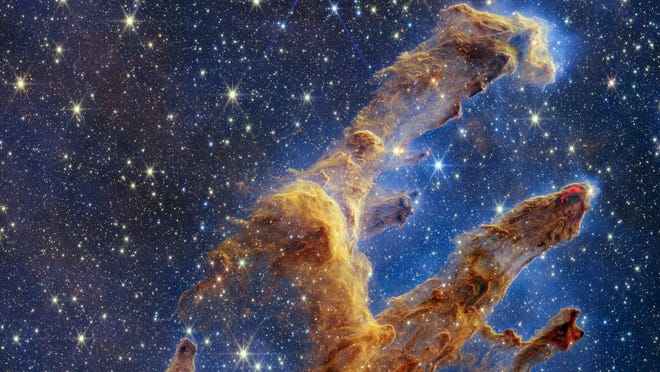The Hubble Telescope has captured a true blast from the past, spotting the colossal explosion of a star from over 11 billion years ago in the first detailed look of a supernova so early in the universe’s history.
The discovery comes over a decade after the telescope took photos of the Abell 370 galaxy cluster in 2010. Researchers were combing through data when just behind the galaxy, they discovered images had been taken of a supernova, which is the dying of a massive star and the largest explosion in space, according to NASA. The findings were published in the peer reviewed journal Nature Wednesday.
Even with the galaxy in the way, it was viewable through a phenomenon known as gravitational lensing – the gravitational force of Abell 370 bends and magnifies the light behind it, making it possible to view the supernova from Earth.
Black hole: Closest known black hole to Earth, sitting 1,600 light-years away, found by astronomers
Asteroid crash: When NASA successfully crashed into an asteroid, these famous telescopes captured the effects
But the chance to spot a supernova is difficult because it all happens in short time frame. It can last for hours or a few days, Wenlei Chen, lead author of the research paper and postdoctoral researcher in the University of Minnesota School of Physics and Astronomy, said in a statement.
But the three images Hubble took captured the early stages of the “stellar explosion.” The first image is taken around six hours after the core collapses, with the second and third image taken days afterward.
Throughout the images, researchers say the supernova went from appearing blue in the early hot phase, to it turning red while cooling down.
“You’ve got the massive star, the core collapses, it produces a shock, it heats up, and then you’re seeing it cool over a week. I think that’s probably one of the most amazing things I’ve ever seen,” said Patrick Kelly, study leader and assistant professor in the University of Minnesota’s School of Physics and Astronomy.
The astronomers were also able to determine the supernova’s size and age due to its brightness and rate of cooling, discovering it is about 500 times larger than the sun and exploded over 11 billion years ago, the oldest and most distant supernova ever observed. NASA estimates the universe to be 13.8 billion years old, meaning the universe was less than a fifth of its current age when the explosion happened.
Researchers hope the discovery will lead to further understanding of the formation of stars and galaxies in the early universe, and if they differ from ones closer to our galaxy. They hope to use the James Webb Space Telescope to observe more, and perhaps more distant, supernovae.
Follow Jordan Mendoza on Twitter: @jordan_mendoza5.
‘Pillars of Creation’: James Webb telescope gives stunning new look at the birthplace of young stars
What’s everyone talking about?: Sign up for our trending newsletter to get the latest news of the day



